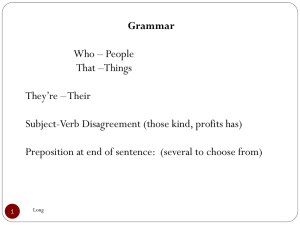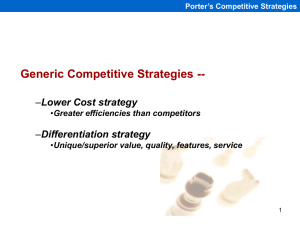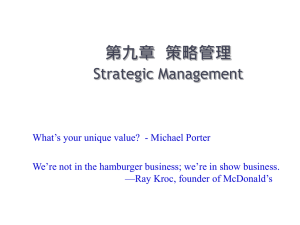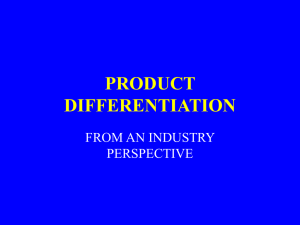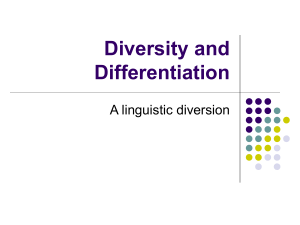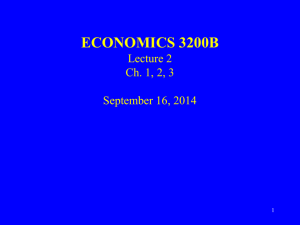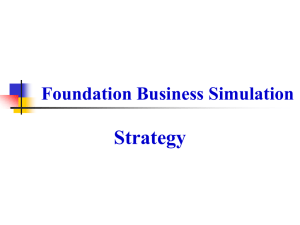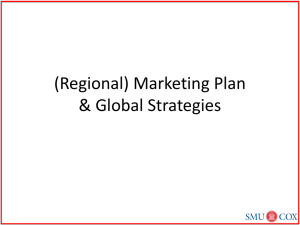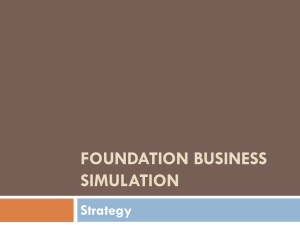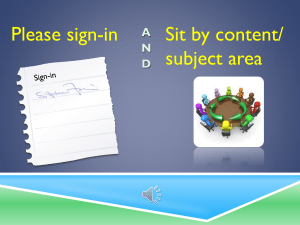Chapter6
advertisement
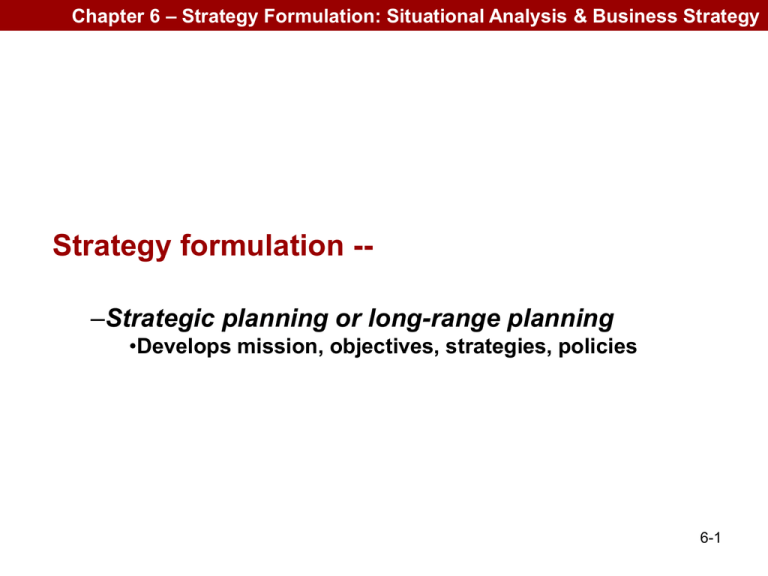
Chapter 6 – Strategy Formulation: Situational Analysis & Business Strategy Strategy formulation -–Strategic planning or long-range planning •Develops mission, objectives, strategies, policies 6-1 Situational Analysis - Process of finding a strategic fit between external opportunities and internal strengths while working around external threats and internal weaknesses 6-2 SFAS (Strategic Factors Analysis Summary) Matrix The SFAS (Strategic Factors Analysis Summary) Matrix summarizes an organization’s strategic factors by combining the external factors from the EFAS Table with the internal factors from the IFAS Table. The SFAS Matrix requires the strategic decision maker to condense these strengths, weaknesses, opportunities, and threats into fewer than ten strategic factors. This is done by reviewing and revising the weight given each factor. The revised weights reflect the priority of each factor as a determinant of the company’s future success. The highest weighted EFAS and IFAS factors should appear in the SFAS Matrix. 6-3 Situational Analysis Niche -–Need in the marketplace that is currently unsatisfied 6-4 Situational Analysis Corporate Goal -–Find favorable niche –Strategic window 6-5 Situational Analysis SWOT -–Internal •Strengths/Weaknesses –External •Opportunities/Threats 6-6 TOWS (Threats, Opportunities, Weaknesses, and Strengths) Matrix The TOWS Matrix is a relatively simple tool for generating strategic options. By using it, you can look intelligently at how you can best take advantage of the opportunities open to you, at the same time that you minimize the impact of weaknesses and protect yourself against threats. Used after detailed analysis of your threats, opportunities, strength and weaknesses, it helps you consider how to use the external environment to your strategic advantage, and so identify some of the strategic options available to you. At a practical level, the only difference between TOWS and SWOT is that TOWS emphasizes the external environment whilst SWOT emphasizes the internal environment. 6-7 Business Strategy Focuses on improving competitive position of company’s products or services within the specific industry or market segment 6-8 Porter’s Competitive Strategies Competitive Strategy -–Low cost –Differentiation –Direct competition –Focus on niche 6-9 Porter’s Competitive Strategies Generic Competitive Strategies -–Lower Cost strategy •Greater efficiencies than competitors –Differentiation strategy •Unique/superior value, quality, features, service 6-10 Porter’s Competitive Strategies Competitive Advantage -–Determined by Competitive Scope •Breadth (wide range and scope) of the target market 6-11 Porter’s Competitive Strategies 6-12 Porter’s Competitive Strategies Cost Leadership -–Low-cost competitive strategy –Broad mass market –Efficient-scale facilities –Cost reductions –Cost minimization 6-13 Porter’s Competitive Strategies Differentiation – –Broad mass market –Unique product/service –Premiums charged –Less price sensitivity 6-14 Porter’s Competitive Strategies Cost-Focus – –Low-cost competitive strategy –Focus on market segment –Niche focused –Cost advantage in market segment 6-15 Porter’s Competitive Strategies Differentiation Focus – –Specific group or geographic market focus –Differentiation in target market –Special needs of narrow target market 6-16 Porter’s Competitive Strategies Stuck in the middle – –No competitive advantage –Below-average performance 6-17 Risks of Generic Strategies Risks of Cost Leadership Risks of Cost isLeadership Cost leadership not Cost leadership is not sustained: • sustained: Competitors imitate. • Competitors imitate. • Technology changes. Technology changes. • •Other bases for cost •leadership Other bases for erode. cost leadership erode. Proximity in differentiation is Proximity in differentiation is lost. lost.focusers achieve even Cost lower cost in segments. Risks of Differentiation Risks of Differentiation Differentiation is not Differentiation is not sustained: • sustained: Competitors imitate. • Competitors imitate. • Bases for differentiation •become Bases less for differentiation important to become less important to buyers. Costbuyers. proximity is lost. Cost proximity is lost. Differentiation focusers achieve even greater differentiation in segments. Risks of Focus Risks ofstrategy Focus is The focus The focus strategy is imitated: imitated: The target segment becomes The targetunattractive: segment becomes structurally unattractive: • structurally Structure erodes. Structure erodes. • •Demand disappears. • Demand disappears. Broadly targeted competitors Broadly targeted competitors overwhelm the segment: the segment: • overwhelm The segment’s •differences The segment’s from other differences from other segments narrow. segments narrow. • The advantages of a •broad The advantages of a line increase. line subsegment increase. Newbroad focusers New focusers subsegment the industry. the industry. 6-18 8 Dimensions of Quality 6-19 Competitive Tactics Timing Tactics -–First mover –Late movers 6-20

